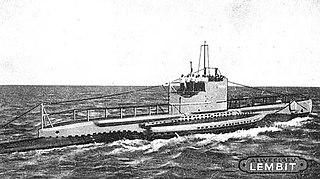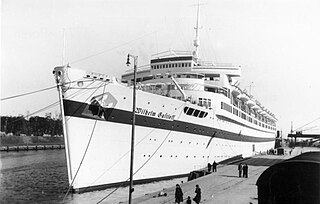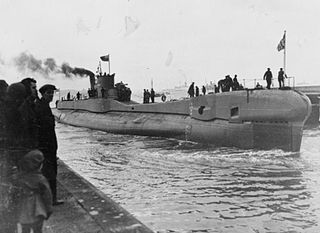
S-13 was a Stalinets-class submarine of the Soviet Navy. Her keel was laid down by Krasnoye Sormovo in Gorky on 19 October 1938. She was launched on 25 April 1939 and commissioned on 31 July 1941 in the Baltic Fleet, under the command of Captain Pavel Malantyenko. The submarine is best known for the 1945 sinking of Wilhelm Gustloff, a German military transport ship. With a career total of 44,701 GRT sunk or damaged, she is the highest-scoring Soviet submarine in history.
German submarine U-30 was a Type VIIA U-boat of Nazi Germany's Kriegsmarine that served during World War II. She was ordered in April 1935 in violation of the Treaty of Versailles, which prevented the construction and commissioning of any U-boats for the German navy, and as part of the German naval rearmament program known as Plan Z. She sank the liner SS Athenia, the first ship sunk in World War II, on 3 September 1939, under the command of Fritz-Julius Lemp. She was retired from front-line service in September 1940 after undertaking eight war patrols, having sunk 17 vessels and damaging two others. U-30 then served in a training role until the end of the war when she was scuttled. She was later raised and broken up for scrap in 1948.

The American Holland-class submarines, also AG class or A class, were Holland 602 type submarines used by the Imperial Russian and Soviet Navies in the early 20th century. The small submarines participated in the World War I Baltic Sea and Black Sea theatres and a handful of them also saw action during World War II.

EML Lembit is one of two Kalev-class mine-laying submarines built for the Republic of Estonia before World War II, and is now a museum ship in Tallinn. She was launched in 1936 at Vickers and Armstrongs Ltd., Barrow-in-Furness in England, and served in the Estonian Navy and the Soviet Navy. Until she was hauled out on 21 May 2011, Lembit was the oldest submarine still afloat in the world. Her sister ship, Kalev, was sunk in October 1941.
The Black Sea Campaigns were the operations of the Axis and Soviet naval forces in the Black Sea and its coastal regions during World War II between 1941 and 1944, including in support of the land forces.
Щ-213 was a Soviet Navy Shchuka-class submarine, Type X. She was built at the Sudostroytelnyi zavod imeny 61 kommunara in Mykolaiv, Ukrainian SSR, and entered service in October 1938 with the Soviet Black Sea fleet.
S-7 was a Stalinets-class submarine of the Soviet Navy. Her keel was laid down by Krasnoye Sormovo in Gorkiy on 14 December 1936. She was launched on 5 April 1937 and commissioned on 30 June 1940 in the Baltic Fleet. During World War II, the submarine was under the command of Captain Sergei Prokofievich Lisin and took part in the Soviet submarine Baltic Sea campaign in 1942. S-7 scored victories, but was sunk in action.
Shch-317 was a Shchuka-class submarine of the Soviet Navy. Her keel was laid down by A. Marti in Leningrad on 23 July 1934. She was launched on 24 September 1935 and commissioned on 29 September 1936 in the Baltic Fleet.
Soviet submarine K-3 was a K-class submarine of the Soviet Navy during World War II.

Submarine warfare in the Black Sea in World War II during 1941 primarily involved engagements between submarines of the Soviet Black Sea Fleet attacking Axis merchantmen defended by Romanian and Bulgarian warships. These engagements were a part of the naval Black Sea campaigns between Axis and Soviet naval forces.

The Soviet Navy launched the Soviet submarine Baltic Sea campaign in 1942 to harass the strategic iron-ore traffic from neutral Sweden to Nazi Germany during World War II. The Soviet Union and the German Reich fought each other on the Eastern Front (1941-1945) during the war. The Allies also launched other operations - especially involving the Royal Navy - against the traffic.

The Gulf of Finland U-boat campaign lasted in the Gulf of Finland during the World War II against the Soviet Union between summer 1944 and spring 1945. During the campaign Finland switched sides and joined the Allies.

The Kara Sea U-boat campaign was a submarine operation in the Arctic waters of the Kara Sea during World War II. Originally intended as "Operation Wunderland-II" protracted after the official end of the operations until 1944.

The Soviet submarine Baltic Sea campaign in 1943 was launched by the Soviet Navy to harass the strategic iron ore traffic from neutral Sweden to Nazi Germany on the Eastern Front during the WWII. Other operations were launched by Allies, especially by the Royal Navy. The offensive was a repetition of the previous campaign in 1942 but resulted in a failed outcome.
Submarine warfare in the Black Sea in World War II during 1942 involved engagements between primarily submarines of the Soviet Black Sea Fleet attacking Axis merchantmen defended by Romanian and German naval warships. These engagements were a part of the Black Sea campaigns between Axis and Soviet naval forces.

Submarine warfare in the Black Sea in World War II during 1943 involved engagements between submarines of the Soviet Black Sea Fleet attacking Axis merchantmen defended by Romanian and German naval warships, as well as and German U-boats attacking Soviet merchants on the eastern Black Sea. These engagements were a part of the Black Sea campaigns between Axis and Soviet naval forces.

Submarine warfare in the Black Sea in World War II during 1944 involved engagements between submarines of the Soviet Black Sea Fleet attacking Axis merchantmen, defended by Romanian and German naval warships, as well as German U-boats and Romanian submarines attacking Soviet merchants on the eastern Black Sea. Before the conclusion of the campaign, Romania joined the Allies after King Michael's Coup. These engagements were a part of the naval Black Sea campaigns.

The Soviet submarine Baltic Sea campaign in 1941 was launched by the Soviet Navy at the early stage of Operation Barbarossa. The offensive was hampered by the quick German ground advance and the retreat of Soviet naval vessels from the main Baltic harbors.

The Soviet naval Baltic Sea campaign in 1945 was launched by the Soviet Navy to harass enemy shipping and naval military assets of Nazi Germany on the Eastern Front during World War II. Both submarines and surface units of the Soviet Navy were employed. The campaign scored successes during Operation Hannibal.

The Barents Sea campaign in 1941 was a submarine operation in the Arctic waters of the Barents Sea during World War II. It was a combined Soviet and British campaign, with boats departing from Polyarny to harass the German shipping lanes along the Norwegian coast.













